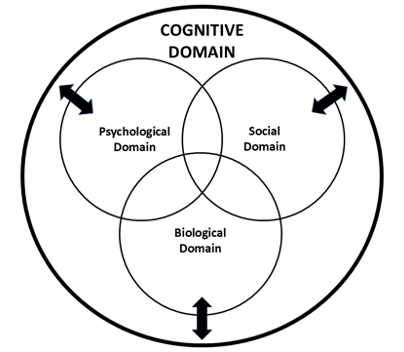As a recent US Army TRADOC’s Mad Scientist Network essay, Project Deterrence – Disruptive Technologies, noted, China is making moves to mutate the character of war. Indeed, it’s estimated that given China’s current foci, scope and pace of scientific and technological efforts – and the seamless integration of these developments into political and military initiatives – that the United States (U.S.) is on course to lose its dominant position in the global power by 2035. China is executing a plan that fuses rapid progress in science and technology (S/T) with defined initiatives in cognitive dominance, both over the US and its allies, and of multinational narratives, attitudes, values and postures. Their aim is to achieve strategic outcomes through influence operations that are incremental; designed to “nudge the needle” on scales of leverage and thereby secure iterative advantage.
As illustrated in the figure below, we posit that the cognitive domain entails biological, psychological, and socio-economic dimensions, which are interactive, non-mutually exclusive, and exert reciprocal effect. Our adversaries are engaging research, developing tools and methods, and applying them in operations in each and all of these domains.

Thus influence can be incurred “inside-out” (e.g.- via direct manipulation of neurocognitive processes and their effects upon behavior), “outside-in” (e.g.- by affecting ecologies/environments, and socio-economics), and/or through combinatory effect (e.g.- influencing various factors, including symbols, narratives, and other information to evoke psycho-physiological responses that shape attitudes, values and actions in individuals and collectives). The tactics are certainly not new: illusion, deception, distraction, disenchantment, and disenfranchisement have been constituents of deterrence – and thus elements of both offensive and defensive operations – throughout history. And now, as arguably with each new epoch of engagement, the tools, pace, capability and extent of effect(s) are what differ.
But it is the nature of that very difference that we must heed. The seasoned adage that the last war’s methods will not win the next is ever more apt in this context. Thus, unless U.S. commitment to cognitive domain S/T, and operational tactics undergo immediate and decisive transformation toward augmented commitment of resources (inclusive of a fortified, more specific conjoinment of the defense-industrial and -research bases, both domestically and in concert with our allies), it is likely that China will out-plan, outpace, and out-power our enterprise, capability, and global power in this space within the next decade. done
Therefore, to regain and retain the U.S.’s strategic edge in cognitive engagement operations, we offer the following recommendations:
- Commit resources to research, development and application(s) of AI-integrated Command and Control (C2) nodes—that is, systems that direct and coordinate military forces—capable of processing Intelligence, Surveillance, and Reconnaissance (ISR) data, which includes real-time information collection and analysis for decision-making, at speeds faster than human operators.
- Prioritize mission-specific research and application of neuroadaptive human-machine interfaces that extend warfighter cognition and executive function under varying information loads, operational tactics, and dynamic threat conditions.
- Develop programs of cognitive readiness education and training that afford tools and techniques to employ both high- and low-tech means of defining, detecting, deterring, and defending against adversaries’ information operations.
- Develop metamaterial-enabled stealth decoys that can be utilized in multi-domain operations with low-probability-of-interception.
- Expand AI-guided maneuvering and shadow operations across land, air, maritime, cyber, and cognitive domains to enable preemptive positioning and operational advantage.
- Establish sustained U.S. and allied cognitive influence through a deliberate and global presence that includes multinational policy to dominate narratives and assert strategic information dominance
Control of this battlespace demands cognitive dominance, which can be achieved by sustained commitment to (1) maintaining advantage in the pace, extent and operationalizability of scientific and technological research and development (R/D); and (2) surveilling peer-competitor and adversaries’ efforts in this domain, to assess both strengths, and to identify, analyze and exploit gaps in capability. We opine that these two foci are complementary, and require concomitant diligence, and dedicated support. Strategic success is forged not by singular moments, but by sustained superiority across cycles of disruption and adaptation.
We view the cognitive battlespace as one in which success is achieved by advantage, which can be gained in, and across a variety of domains and dimensions (of time, locale, ecology, collectives, etc.) that can be selectively engaged to elicit particular hegemonic effect. Influence, when accelerated through technologically-optimized command, can achieve outcomes faster and with greater efficiency than traditional force. In this light, we metaphorically argue that it would be unwise, if not inapt, and certainly unrealistic for the U.S. and its allies to bring even a well-crafted chess set and playbook to a game of Go, and expect success. Battlescapes, like boardgames, have different rules, timescales, metric, and definitions of victory. Thus, we ask, what shall be our next move(s)?
The views and opinions expressed in this essay are those of the authors, and do not necessarily reflect those of the United States government, Department of Defense, or the National Defense University.
 Elise Annett is the Institutional Research, Assessment, and Accreditation Associate at the Eisenhower School for National Security and Resource Strategy; and is a doctoral candidate at Georgetown University. Her work addresses operational and ethical issues of iteratively autonomous AI systems in military use.
Elise Annett is the Institutional Research, Assessment, and Accreditation Associate at the Eisenhower School for National Security and Resource Strategy; and is a doctoral candidate at Georgetown University. Her work addresses operational and ethical issues of iteratively autonomous AI systems in military use.
 Dr. James Giordano is the Director of the Center for Disruptive Technology and Future Warfare of the Institute for National Strategic Studies at the National Defense University.
Dr. James Giordano is the Director of the Center for Disruptive Technology and Future Warfare of the Institute for National Strategic Studies at the National Defense University.
Contact: james.j.giordano.civ@ndu.edu